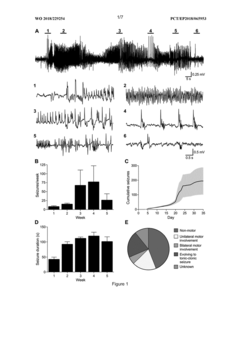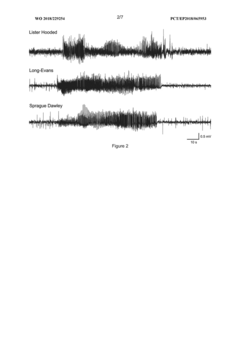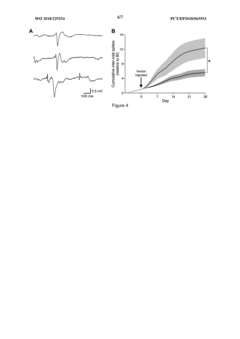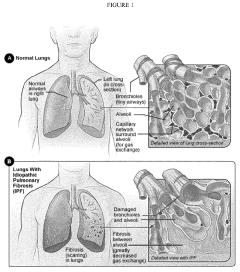Evaluating Pentose Phosphate Pathway's Potential in Gene Therapy
Pentose Phosphate Pathway in Gene Therapy: Background and Objectives
The Pentose Phosphate Pathway (PPP) has emerged as a promising avenue for enhancing gene therapy approaches. This metabolic pathway, discovered in the 1950s, plays a crucial role in cellular metabolism by generating NADPH and ribose-5-phosphate, essential components for various cellular processes. In recent years, researchers have begun to explore the potential of pentose phosphate pathway in improving the efficacy and safety of gene therapy techniques.
The primary objective of evaluating PPP's potential in gene therapy is to leverage its metabolic functions to optimize gene delivery, expression, and overall therapeutic outcomes. By understanding and manipulating the PPP, scientists aim to enhance the cellular environment for successful gene integration and expression, potentially overcoming some of the current limitations in gene therapy.
One of the key areas of interest is the PPP's role in oxidative stress management through NADPH production. Gene therapy often induces cellular stress, which can negatively impact treatment efficacy. By harnessing the PPP's ability to generate NADPH, researchers hope to improve cell survival and function during and after gene therapy procedures, potentially leading to more successful outcomes.
Another critical aspect is the PPP's involvement in nucleotide synthesis through ribose-5-phosphate production. This function is particularly relevant in gene therapy, as it directly impacts the cell's ability to replicate and express introduced genetic material. By modulating the PPP, researchers aim to create a more favorable environment for gene integration and expression, potentially enhancing the overall efficiency of gene therapy techniques.
The evolution of gene therapy techniques has highlighted the need for a more comprehensive understanding of cellular metabolism in therapeutic contexts. As gene therapy moves beyond rare genetic disorders to address more common diseases, the potential of metabolic pathways like the PPP in improving treatment outcomes becomes increasingly significant.
Recent advancements in metabolic engineering and synthetic biology have opened new possibilities for manipulating the PPP in the context of gene therapy. These developments have led to a growing interest in exploring how the pathway can be fine-tuned to optimize gene delivery vectors, enhance target cell receptivity, and improve the long-term stability of therapeutic genes.
As research in this field progresses, the ultimate goal is to develop more effective and safer gene therapy strategies by integrating our understanding of the PPP with cutting-edge gene delivery and expression technologies. This interdisciplinary approach holds promise for addressing current challenges in gene therapy and expanding its applications across a broader range of medical conditions.
Market Analysis for Gene Therapies Based on The Pentose Phosphate Pathway
The market for gene therapies based on the Pentose Phosphate Pathway (PPP) is emerging as a promising segment within the broader gene therapy landscape. As researchers continue to uncover the potential of PPP in cellular metabolism and its impact on genetic disorders, the demand for PPP-based gene therapies is expected to grow significantly in the coming years.
The global gene therapy market, valued at approximately $7.8 billion in 2020, is projected to reach $35.7 billion by 2027, with a compound annual growth rate (CAGR) of 22.7%. Within this rapidly expanding market, PPP-based gene therapies are poised to capture a substantial share due to their unique approach to addressing genetic disorders related to cellular metabolism.
Several factors are driving the market demand for PPP-based gene therapies. Firstly, the increasing prevalence of genetic disorders associated with metabolic dysfunction has created a pressing need for innovative treatment options. PPP plays a crucial role in cellular redox balance and nucleotide synthesis, making it an attractive target for gene therapy interventions in metabolic disorders.
Furthermore, advancements in gene editing technologies, such as CRISPR-Cas9, have opened up new possibilities for manipulating the PPP pathway with greater precision. This has led to increased interest from both academic researchers and pharmaceutical companies in developing PPP-based gene therapies.
The market for PPP-based gene therapies is expected to be particularly strong in regions with high healthcare expenditure and advanced research infrastructure. North America and Europe are likely to be the primary markets initially, followed by Asia-Pacific as regulatory frameworks and healthcare systems in these regions continue to evolve.
One of the key market segments for PPP-based gene therapies is expected to be rare genetic disorders affecting cellular metabolism. These conditions often have limited treatment options, creating a significant unmet medical need that PPP-based therapies could address. Additionally, the potential applications of PPP manipulation in cancer treatment represent another substantial market opportunity.
However, the market for PPP-based gene therapies also faces several challenges. The high cost of development and production of gene therapies remains a significant barrier to market entry and widespread adoption. Regulatory hurdles and the need for long-term safety data may also slow market growth in the short term.
Despite these challenges, the potential of PPP-based gene therapies to offer transformative treatments for previously untreatable genetic disorders is driving substantial investment in research and development. As clinical trials progress and more data becomes available, the market for these therapies is expected to expand rapidly, potentially revolutionizing the treatment of metabolic genetic disorders.
Current State and Challenges of Gene Therapy Based on The Pentose Phosphate Pathway
The current state of gene therapy utilizing the Pentose Phosphate Pathway (PPP) is characterized by promising potential but significant challenges. Research has demonstrated the PPP's crucial role in cellular metabolism, particularly in generating NADPH and ribose-5-phosphate, which are essential for nucleotide synthesis and redox homeostasis. These functions make the PPP an attractive target for gene therapy applications, especially in diseases involving metabolic dysregulation or oxidative stress.
Recent advancements in gene editing technologies, such as CRISPR-Cas9, have opened new avenues for manipulating PPP-related genes. Several studies have successfully modulated key enzymes in the pathway, including glucose-6-phosphate dehydrogenase (G6PD) and transketolase, demonstrating potential therapeutic effects in various disease models. For instance, upregulation of G6PD has shown promise in mitigating oxidative stress in neurodegenerative disorders.
However, the field faces several significant challenges. One major hurdle is the complexity of the PPP and its interconnections with other metabolic pathways. Altering PPP activity can have far-reaching effects on cellular metabolism, making it difficult to predict and control the outcomes of gene therapy interventions. This complexity necessitates a more comprehensive understanding of the pathway's regulation and its interactions with other cellular processes.
Another challenge lies in the delivery of gene therapy vectors targeting PPP enzymes. While adeno-associated viruses (AAVs) have shown promise as delivery vehicles, achieving tissue-specific and efficient gene transfer remains problematic. The large size of some PPP enzyme genes also poses packaging limitations for viral vectors, requiring the development of more advanced delivery systems.
Safety concerns present another significant obstacle. Modulating PPP activity can potentially lead to unintended consequences, such as altered cell proliferation or metabolic imbalances. Long-term effects of PPP-targeted gene therapies are not yet fully understood, necessitating extensive preclinical studies and careful monitoring in clinical trials.
Furthermore, the heterogeneity of PPP activity across different cell types and tissues complicates the development of universally effective therapies. Tailoring treatments to specific cellular contexts while minimizing off-target effects remains a considerable challenge.
Regulatory hurdles also pose significant challenges. The novelty of PPP-targeted gene therapies means that regulatory frameworks are still evolving, potentially leading to longer approval processes and increased development costs.
Despite these challenges, the field continues to advance. Ongoing research focuses on developing more precise gene editing techniques, improving vector design for enhanced specificity and reduced immunogenicity, and elucidating the complex regulatory networks governing PPP activity. These efforts aim to overcome current limitations and unlock the full potential of PPP-based gene therapies in treating a wide range of diseases.
Existing Pentose Phosphate Pathway-Based Gene Therapy Approaches
01 Genetic engineering of the pentose phosphate pathway
Genetic modifications are made to enhance or alter the pentose phosphate pathway in microorganisms. This can involve introducing new genes, modifying existing genes, or altering regulatory elements to improve the efficiency of the pathway or to produce specific desired compounds.- Genetic engineering of the pentose phosphate pathway: Genetic modifications are made to enhance or alter the pentose phosphate pathway in microorganisms. This can involve introducing new genes, modifying existing genes, or altering regulatory elements to improve flux through the pathway. Such modifications can lead to increased production of desired compounds or improved metabolic efficiency.
- Utilization of pentose phosphate pathway for biofuel production: The pentose phosphate pathway is exploited for the production of biofuels. This involves engineering microorganisms to efficiently convert pentose sugars into biofuel precursors or directly into biofuels. Strategies may include optimizing enzyme expression, redirecting metabolic flux, or introducing heterologous pathways.
- Regulation and control of pentose phosphate pathway: Methods and systems for regulating and controlling the pentose phosphate pathway are developed. This can involve manipulating regulatory proteins, using small molecule modulators, or employing synthetic biology approaches to achieve desired flux through the pathway. Such control mechanisms can be used to optimize metabolic processes for various applications.
- Pentose phosphate pathway in metabolic engineering: The pentose phosphate pathway is utilized in metabolic engineering efforts to produce valuable compounds. This involves redirecting carbon flux through the pathway to generate precursors for target molecules or to improve overall cellular metabolism. Applications can include the production of pharmaceuticals, fine chemicals, or industrial enzymes.
- Analysis and characterization of pentose phosphate pathway enzymes: Techniques for analyzing and characterizing enzymes involved in the pentose phosphate pathway are developed. This can include structural studies, kinetic analyses, or investigation of regulatory mechanisms. Such research provides insights into pathway function and can inform strategies for pathway engineering or drug development targeting these enzymes.
02 Metabolic engineering for biofuel production
The pentose phosphate pathway is engineered in microorganisms to improve the production of biofuels. This involves optimizing the pathway to increase the yield of precursor molecules or to directly produce biofuel compounds, often in conjunction with other metabolic pathways.Expand Specific Solutions03 Regulation and control of the pentose phosphate pathway
Methods and systems are developed to regulate and control the pentose phosphate pathway. This can include the use of specific enzymes, cofactors, or regulatory molecules to modulate the flux through the pathway, optimizing it for various biotechnological applications.Expand Specific Solutions04 Utilization of pentose sugars in fermentation processes
Techniques are developed to improve the utilization of pentose sugars, such as xylose and arabinose, in fermentation processes. This often involves engineering microorganisms to more efficiently metabolize these sugars through the pentose phosphate pathway.Expand Specific Solutions05 Application in pharmaceutical and nutraceutical production
The pentose phosphate pathway is exploited for the production of pharmaceutical and nutraceutical compounds. This can involve using the pathway to generate specific precursor molecules or to produce the desired compounds directly through engineered biosynthetic pathways.Expand Specific Solutions
Key Players in Pentose Phosphate Pathway Gene Therapy Research
The evaluation of the Pentose Phosphate Pathway's potential in gene therapy is currently in an emerging stage, with a growing market size driven by increasing research and development efforts. The technology's maturity is still evolving, with companies like Regeneron Pharmaceuticals, Biogen MA, and GlaxoSmithKline Intellectual Property leading the way in advancing its applications. The competitive landscape is characterized by a mix of established pharmaceutical companies and research institutions, such as Yale University and the University of California, collaborating to unlock the pathway's therapeutic potential. As the field progresses, we can expect to see more clinical trials and potential breakthroughs, particularly in metabolic disorders and cancer treatments.
Regeneron Pharmaceuticals, Inc.
Biogen MA, Inc.
Core Innovations in PPP Gene Therapy
- Development of an engineered KCNA 1 gene encoding an edited Kv1.1 potassium channel, packaged in a lentiviral vector, which is designed to enhance translation and activity, and includes a cell-type specific promoter to ensure targeted expression in neurons, reducing the risk of exacerbating seizure activity.
- Development of MiniVectors, which are non-viral, supercoiled circular DNA constructs devoid of bacterial sequences, designed to specifically target and inhibit key genes implicated in fibrosis using inhibitory RNA or gene expression, allowing for repeated and safe delivery with reduced immune response and integration risks.
Regulatory Framework for Gene Therapies Utilizing The Pentose Phosphate Pathway
The regulatory framework for gene therapies utilizing the Pentose Phosphate Pathway (PPP) is a complex and evolving landscape. As this field advances, regulatory bodies worldwide are working to establish guidelines that ensure safety, efficacy, and ethical considerations while fostering innovation.
In the United States, the Food and Drug Administration (FDA) plays a pivotal role in regulating PPP-based gene therapies. The FDA's Center for Biologics Evaluation and Research (CBER) oversees the approval process, which typically involves rigorous preclinical and clinical trials. The agency has implemented a phased approach, requiring extensive safety data and proof of concept before progressing to larger-scale human trials.
The European Medicines Agency (EMA) has also developed specific guidelines for gene therapy medicinal products, which encompass PPP-based approaches. The EMA's Committee for Advanced Therapies (CAT) provides scientific recommendations on these novel treatments, emphasizing long-term follow-up studies to monitor potential delayed adverse effects.
Globally, the International Council for Harmonisation of Technical Requirements for Pharmaceuticals for Human Use (ICH) has been instrumental in harmonizing regulatory standards. The ICH's guidelines on gene therapy products provide a framework for quality, safety, and efficacy considerations that many countries have adopted or referenced in their national regulations.
One of the key regulatory challenges for PPP gene therapies is the assessment of long-term safety. Regulatory bodies are increasingly requiring extended follow-up periods, sometimes spanning decades, to monitor for potential late-onset side effects or unintended genetic modifications.
Another critical aspect of the regulatory framework is the consideration of vector systems used in PPP gene therapies. Viral vectors, such as adeno-associated viruses (AAVs), are commonly used and subject to specific regulatory scrutiny regarding their production, purity, and potential for immunogenicity.
The regulatory landscape also addresses the ethical implications of gene therapy, particularly when it comes to germline modifications. Most regulatory frameworks currently prohibit genetic alterations that could be passed on to future generations, limiting PPP gene therapies to somatic cell applications.
As the field progresses, regulators are adapting to the rapid pace of scientific advancements. Many agencies now offer accelerated approval pathways for breakthrough therapies, recognizing the potential of PPP-based approaches to address unmet medical needs. However, these expedited processes still maintain rigorous safety and efficacy standards.
Ethical Implications of Pentose Phosphate Pathway in Gene Therapy
The ethical implications of using the Pentose Phosphate Pathway (PPP) in gene therapy are multifaceted and require careful consideration. As this emerging field progresses, it is crucial to address the potential ethical concerns to ensure responsible development and application of this technology.
One primary ethical consideration is the safety of PPP-based gene therapies. While the PPP is a fundamental metabolic pathway, altering its function for therapeutic purposes may have unintended consequences on cellular metabolism and overall health. Researchers must conduct thorough pre-clinical and clinical trials to assess both short-term and long-term effects, ensuring that the benefits outweigh any potential risks.
The issue of informed consent is particularly pertinent in PPP gene therapy. Given the complexity of the pathway and its interactions within cellular metabolism, it may be challenging to fully explain the potential outcomes to patients. Healthcare providers and researchers must develop clear, comprehensive communication strategies to ensure that patients can make truly informed decisions about their treatment.
Equity and access to PPP gene therapies also raise ethical questions. As with many advanced medical treatments, there is a risk that these therapies may only be available to a select few due to high costs or limited availability. This could exacerbate existing healthcare disparities and raise issues of social justice. Efforts must be made to ensure equitable access to these potentially life-changing treatments.
The potential for off-target effects in PPP gene therapy is another ethical concern. Modifications to the PPP could potentially affect other metabolic pathways or cellular processes, leading to unforeseen consequences. Researchers must develop highly specific and targeted approaches to minimize these risks and establish robust monitoring protocols for patients undergoing treatment.
There are also broader societal implications to consider. The ability to manipulate fundamental metabolic pathways like the PPP could be seen as a step towards human enhancement rather than just therapeutic intervention. This raises questions about the boundaries between treatment and enhancement, and the potential for creating new forms of inequality based on genetic modifications.
Lastly, the use of PPP gene therapy in germline cells could have far-reaching consequences for future generations. While current regulations generally prohibit germline modifications, the potential for such applications in the future necessitates careful ethical deliberation. The long-term effects of altering the PPP in ways that could be inherited by future generations must be thoroughly examined and debated.






